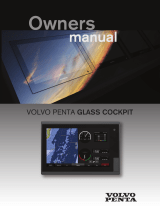
1
Hold a handheld compass in the CCU mounting location.
2
Move the compass six inches to the left of the location, then
six inches to the right, observe the needle, and select an
action:
• If the compass needle moves more than three degrees
during this step, magnetic interference is present. Select a
new mounting location and repeat the test.
• If the compass needle does not move, or moves less than
three degrees, proceed to the next step.
3
Repeat this process while moving the compass above and
below the mounting location.
4
Repeat this process while moving the compass in front of and
behind the mounting location.
Alarm Mounting and Connection Considerations
• The alarm should be mounted near the primary helm station.
• The alarm can be mounted under the dashboard.
• If needed, the alarm wires can be extended with 28 AWG
(0.08 mm
2
) wire.
NMEA 2000
®
Connection Considerations
• The CCU and the helm control must connect to a NMEA
2000 network.
• If your boat does not already have a NMEA 2000 network,
one can be built using the included NMEA 2000 cables and
connectors (Building a Basic NMEA 2000 Network for the
Autopilot System, page 3).
• To use the advanced features of the autopilot, optional
NMEA 2000 devices, such as a wind sensor, a water-speed
sensor, or a GPS device, can be connected to the NMEA
2000 network.
Power and Data Layout
WARNING
When connecting the power cable, do not remove the in-line
fuse holder. To prevent the possibility of injury or product
damage caused by fire or overheating, the appropriate fuse
must be in place as indicated in the product specifications. In
addition, connecting the power cable without the appropriate
fuse in place voids the product warranty.
Item Description Important Considerations
À
Helm control A dedicated helm control is not included in all
autopilot packages. If you install the autopilot
without a dedicated helm control, the autopilot
CCU must be connected to the same NMEA
2000 network as a compatible Garmin
chartplotter to configure and control the autopilot
system.
Á
Helm control
data cable
You should install this cable only if you are
connecting the autopilot to optional NMEA
®
0183
devices, such as a wind sensor, a water-speed
sensor, or a GPS device (NMEA 0183
Connection Considerations, page 4).
Â
NMEA 2000
power cable
You should install this cable only if you are
building a NMEA 2000 network. Do not install this
cable if there is an existing NMEA 2000 network
on your boat.
You must connect the NMEA 2000 power cable
to a 9 to 16 Vdc power source.
Ã
NMEA 2000
network
You must connect the helm control or compatible
Garmin chartplotter and the CCU to a NMEA
2000 network using the included T-
connectorsNMEA 2000
®
Connection
Considerations, page 2.
If there is not an existing NMEA 2000 network on
your boat, you can build one using the supplied
cables and connectors (Building a Basic NMEA
2000 Network for the Autopilot System,
page 3).
Ä
CCU You can mount the CCU in a non-submerged
location near the center of the boat, in any
orientation (CCU Mounting and Connection
Considerations, page 1).
Mount the CCU away from sources of magnetic
interference.
Å
Engine
connection
The CCU connects to the engine control either
directly or through an adapter. Additional
instructions are provided with the adapter, if
applicable.
Æ
Alarm The alarm provides audible alerts from the
autopilot system, and you should install it near
the primary helm station (Installing the Alarm,
page 3).
Installation Procedures
CAUTION
Always wear safety goggles, ear protection, and a dust mask
when drilling, cutting, or sanding.
NOTICE
When drilling or cutting, always check what is on the opposite
side of the surface.
After you have planned the autopilot installation on your boat
and satisfied all of the mounting and wiring considerations for
your particular installation, you can begin mounting and
connecting the components.
Helm Control Installation
A dedicated helm control is not included in all autopilot
packages. If you install the autopilot without a dedicated helm
control, the autopilot CCU must be connected to the same
NMEA 2000 network as a compatible Garmin chartplotter to
configure and control the autopilot system.
Detailed mounting instructions are included in the helm control
box.
Mounting the CCU
1
Determine the mounting location.
2
Using the CCU as a template, mark the two pilot hole
locations on the mounting surface.
3
Using a 3 mm (
1
/
8
in.) bit, drill the pilot holes.
2







